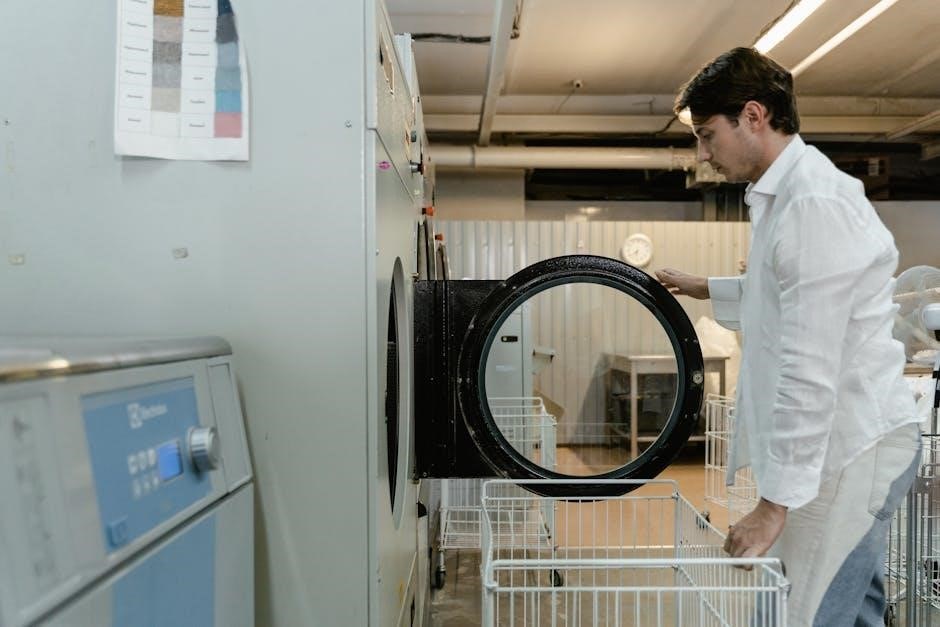Ingersoll Rand air dryers are reliable, high-quality solutions for removing moisture from compressed air, offering both refrigerated and desiccant models to meet various industrial needs.
1.1. Overview of Ingersoll Rand Air Dryers
Ingersoll Rand air dryers are designed to provide efficient moisture removal from compressed air systems. They are available in two main types: refrigerated and desiccant dryers. Refrigerated models are ideal for general industrial applications, offering energy efficiency and reliable performance. Desiccant dryers, including heatless and heated options, are suited for harsh environments requiring lower dew points. Both types are known for their durability and advanced control panels. They cater to various industries, ensuring optimal air quality and system protection. Energy-saving features and zero-loss condensate drains are also available.
1.2. Importance of Proper Installation and Maintenance
Proper installation and maintenance are critical for optimal performance and longevity of Ingersoll Rand air dryers. Incorrect installation can lead to inefficiency, safety hazards, and equipment damage. Regular maintenance ensures the removal of contaminants, prevents corrosion, and maintains air quality. It also extends the lifespan of the dryer and reduces operational costs. Adhering to the manufacturer’s guidelines ensures compliance with safety standards and warranty conditions. Proper upkeep guarantees reliable operation, minimizing downtime and ensuring continuous production. Regular checks and timely repairs are essential for maintaining peak efficiency and safety.

Installation and Setup
Proper installation of Ingersoll Rand air dryers requires careful site preparation, alignment with manufacturer guidelines, and ensuring all safety and efficiency standards are met for optimal system performance.
2.1. Pre-Installation Checks and Requirements
Before installing an Ingersoll Rand air dryer, ensure the site meets all specified requirements. Verify that the electrical supply matches the dryer’s specifications and that the compressed air system is free from contamination. Check for proper ventilation and ensure the floor is level and sturdy to support the unit’s weight. Review the manual for specific inlet and outlet connection sizes and ensure all necessary components, such as filters and drains, are in place. Proper preparation is essential for safe and efficient operation.
2.2. Step-by-Step Installation Guide
Begin by connecting the dryer to the compressed air system, ensuring all inlet and outlet connections are secure and properly sized. Mount the unit on a level, stable surface and connect the electrical supply according to the specifications in the manual. Turn on the power and allow the system to cycle through its initial startup sequence. Check for leaks at all connections and ensure proper drainage of condensate. Finally, test the dryer under normal operating conditions to confirm it is functioning correctly and delivering dry air as expected.

Operation and Maintenance
Regularly monitor the control panel, ensure proper airflow, and clean filters to maintain efficiency. Drain condensate daily and inspect for wear or damage to ensure reliable performance.
3.1. Control Panel Functions and Features
The control panel of Ingersoll Rand air dryers offers advanced monitoring and management capabilities. It includes a display for visualizing system status and signaling LEDs to indicate operational modes, alarms, and maintenance needs. The panel features keys for programming condensate discharge parameters and navigating through settings. Remote signaling alarms can be activated to notify personnel of issues. The control panel also supports energy-saving modes, low-load operation, and provides real-time feedback to ensure optimal performance and efficiency. These features simplify operation, troubleshooting, and maintenance, ensuring reliable compressed air drying processes.
3.2. Regular Maintenance Tasks for Optimal Performance
Regular maintenance is essential for ensuring the longevity and efficiency of Ingersoll Rand air dryers. Key tasks include checking and cleaning condensate drains to prevent blockages, inspecting and replacing air filters to maintain airflow, and ensuring proper electrical connections. Additionally, users should verify that all tubing and connections are secure and free from leaks. Routine inspection of the control panel and sensors is also crucial to detect early signs of wear or malfunction. Following these steps ensures consistent performance, prevents downtime, and extends the service life of the dryer.

Safety Precautions
Adhere to safety guidelines to prevent accidents. Ensure the system is not under pressure or powered during maintenance. Only qualified personnel should perform adjustments or repairs.
4.1. General Safety Guidelines
Always follow safety protocols to ensure safe operation and maintenance. Disconnect power and release system pressure before performing any service. Wear protective gear, including gloves and safety glasses. Avoid exposing the dryer to extreme temperatures or corrosive environments. Ensure proper ventilation to prevent moisture buildup. Never bypass safety devices or attempt repairs while the unit is operational. Regularly inspect electrical connections and tubing for damage. Adhere to local regulations and manufacturer recommendations for installation and use. Keep the area clean and well-lit to minimize hazards. Proper training is essential for personnel handling the equipment.
4.2. Emergency Shutdown Procedures
In case of an emergency, immediately stop the dryer and isolate it from the power source. Disconnect the electrical supply and close the compressed air inlet and outlet valves. Release any residual pressure in the system safely. Do not attempt to restart the unit until the issue is resolved. If a malfunction occurs, contact authorized Ingersoll Rand service personnel. Keep emergency contact information readily available. Always prioritize personnel safety and follow proper shutdown protocols to prevent further risks or damage.

Troubleshooting Common Issues
Identify issues like error codes, low airflow, or condensate leaks. Check connections, ensure proper drainage, and consult the manual for specific solutions or contact support if needed.
5.1. Identifying Common Problems
Common issues with Ingersoll Rand air dryers include no power, incorrect phase connections, and ice formation in the evaporator. Other problems may involve condensate drain malfunctions or error codes displayed on the control panel. These issues often stem from improper installation, electrical disruptions, or clogged tubing. Users should refer to the manual for troubleshooting guides, ensuring all connections are secure and systems are properly maintained to prevent downtime and optimize performance. Early detection of these problems is crucial for maintaining efficiency and extending the lifespan of the dryer.
5.2. Diagnostic Techniques and Solutions
For Ingersoll Rand air dryers, start by checking power lines and phase connections if the unit has no power. Inspect sensors and probes for accuracy, and ensure the evaporator is free from ice buildup. Reset the system or replace faulty components like control boards or drains. Use the control panel to identify error codes and address them accordingly. Regularly clean or replace air filters to prevent clogs. If issues persist, consult the manual or contact Ingersoll Rand support for professional assistance to restore optimal functionality.

Warranty Information
Ingersoll Rand air dryers are covered by a 12-month warranty from startup or 18 months from shipment, excluding normal wear, corrosion, and erosion. Additional warranties must be negotiated separately.
6.1. Coverage and Duration
The Ingersoll Rand air dryer warranty covers defects in materials and workmanship for 12 months from startup or 18 months from shipment. This period ensures protection against manufacturing defects, providing customers with assurance of product quality. However, the warranty excludes coverage for normal wear, corrosion, and erosion, which are considered standard maintenance issues. Any additional warranty terms must be negotiated separately with Ingersoll Rand. This warranty reflects the company’s commitment to delivering reliable products while outlining clear expectations for maintenance and repairs.
6.2. Exclusions and Limitations
The warranty excludes coverage for issues arising from normal wear, corrosion, or erosion, as these are considered standard maintenance responsibilities. Performance warranties are limited to those explicitly stated in the company’s proposal. Implied warranties of merchantability and fitness for a particular purpose are disclaimed. Any additional warranties must be negotiated separately. The company’s obligation is limited to correcting defects in materials and workmanship within the specified warranty period, ensuring clarity on what is covered and what requires separate agreement or maintenance.

Different Types of Ingersoll Rand Air Dryers
Ingersoll Rand offers refrigerated and desiccant air dryers, each designed to remove moisture from compressed air, ensuring optimal performance for various industrial applications.
7.1. Refrigerated Air Dryers
Ingersoll Rand refrigerated air dryers efficiently remove moisture from compressed air by cooling it, ensuring optimal performance in various industrial applications. These dryers use a refrigeration system to lower the air temperature, causing condensation and separation of water vapor. They are designed for general industrial use, with a typical pressure dew point of 35°F to 50°F. Key components include compressors, condensers, and evaporators. Regular maintenance, such as filter changes and drain checks, is essential for consistent operation. These dryers are cost-effective and suitable for applications where ambient temperatures are not excessively low.
7.2. Desiccant Air Dryers
Ingersoll Rand desiccant air dryers use adsorption technology to remove moisture from compressed air, ensuring dry air output for critical applications. These dryers feature two towers filled with desiccant beads, alternating between drying and regeneration modes. The desiccant absorbs moisture, and during regeneration, dry air is used to reactivate the beads. They are ideal for applications requiring very low dew points, such as in pharmaceuticals or electronics. Regular maintenance, including desiccant replacement and filter checks, ensures optimal performance and prevents moisture buildup in compressed air systems.
